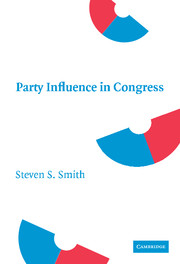Book contents
- Frontmatter
- Contents
- Acknowledgments
- 1 Introduction
- 2 The Microfoundations of Theories of Congressional Parties
- 3 The Types and Sources of Party Influence
- 4 The Search for Direct Party Effects
- 5 Recent Theories of Party Influence: Cartel and Conditional Party Government Theory
- 6 Revisiting Pivotal and Party Politics
- 7 Reexamining the Direct and Indirect Influence of Party in the House and Senate
- 8 More Than a Conclusion
- Appendix
- References
- Index
4 - The Search for Direct Party Effects
Published online by Cambridge University Press: 05 June 2012
- Frontmatter
- Contents
- Acknowledgments
- 1 Introduction
- 2 The Microfoundations of Theories of Congressional Parties
- 3 The Types and Sources of Party Influence
- 4 The Search for Direct Party Effects
- 5 Recent Theories of Party Influence: Cartel and Conditional Party Government Theory
- 6 Revisiting Pivotal and Party Politics
- 7 Reexamining the Direct and Indirect Influence of Party in the House and Senate
- 8 More Than a Conclusion
- Appendix
- References
- Index
Summary
In the first systematic study of congressional voting, A. Lawrence Lowell (1902) reported on the frequency with which 90 percent or more of one party opposed 90 percent or more of the other party on congressional and British House of Commons roll-call votes, finding far more party voting in the House of Commons than in the houses of Congress. Lowell wrote of party influence but was just as likely to more properly refer to the frequency of “party lines.” Indeed, Lowell was quite aware of the limitations of his approach. He noted how rules (such as those affecting the ease of getting roll-call votes or the treatment of public and private bills) might influence his measure of party voting. And he was quite aware that the limited capacities of American electoral parties in formulating a policy program, determining candidates, and controlling incumbents' behavior prevented “government by party” in the United States. Still, Lowell's emphasis was that party influence was stronger in the House of Commons than in the House of Representatives and others followed in his footsteps.
Lowell, who graduated from Harvard College in mathematics and then from Harvard Law, joined Harvard's government department in 1897 and became Harvard's president in 1909, the year he also became president of the American Political Science Association. Between 1897 and 1909, he wrote four books (two of them in two volumes). At Harvard, he remains well known for inventing the system of concentrations (majors) and the reading period before exams (Yeomans 1948).
- Type
- Chapter
- Information
- Party Influence in Congress , pp. 82 - 113Publisher: Cambridge University PressPrint publication year: 2007



